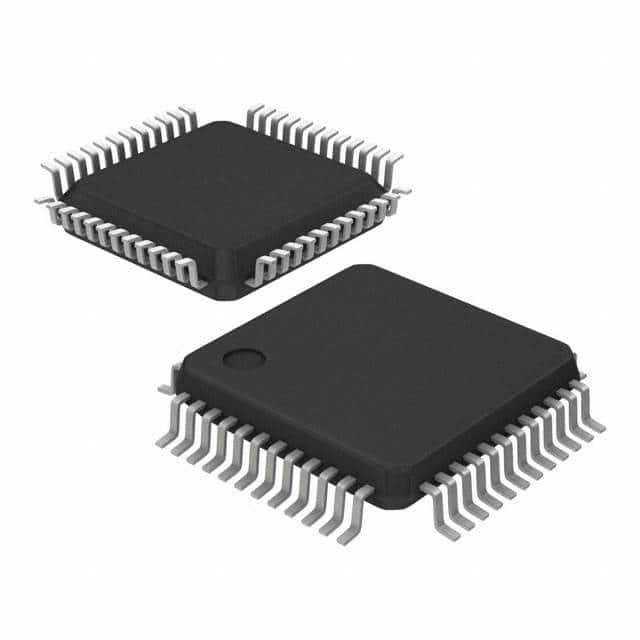MSP430F2417TPMR
Product Overview
Category
MSP430F2417TPMR belongs to the category of microcontrollers.
Use
This microcontroller is commonly used in various electronic devices and systems for control and processing purposes.
Characteristics
- Low power consumption
- High performance
- Integrated peripherals
- Small form factor
- Wide operating voltage range
Package
MSP430F2417TPMR is available in a small-sized package, making it suitable for compact designs and space-constrained applications.
Essence
The essence of MSP430F2417TPMR lies in its ability to provide efficient control and processing capabilities while consuming minimal power.
Packaging/Quantity
This microcontroller is typically packaged individually and is available in various quantities depending on the manufacturer's specifications.
Specifications
- Architecture: 16-bit RISC
- Clock Speed: Up to 16 MHz
- Flash Memory: 120 KB
- RAM: 10 KB
- Operating Voltage Range: 1.8V - 3.6V
- Digital I/O Pins: 48
- Analog Inputs: 12
- Serial Communication Interfaces: UART, SPI, I2C
- Timers: 4x 16-bit
- ADC Resolution: 12-bit
- Operating Temperature Range: -40°C to +85°C
Detailed Pin Configuration
The MSP430F2417TPMR microcontroller has a total of 64 pins. The pin configuration is as follows:
- P1.x: Digital I/O pins (x = 0 to 7)
- P2.x: Digital I/O pins (x = 0 to 7)
- P3.x: Digital I/O pins (x = 0 to 7)
- P4.x: Digital I/O pins (x = 0 to 7)
- P5.x: Digital I/O pins (x = 0 to 7)
- P6.x: Digital I/O pins (x = 0 to 7)
- P7.x: Digital I/O pins (x = 0 to 7)
- P8.x: Digital I/O pins (x = 0 to 7)
- P9.x: Digital I/O pins (x = 0 to 7)
- P10.x: Digital I/O pins (x = 0 to 7)
- A0-A11: Analog input pins
- AVSS: Analog ground
- AVCC: Analog power supply
- DVSS: Digital ground
- DVCC: Digital power supply
- RST: Reset pin
- TEST: Test mode pin
- XIN: Crystal oscillator input
- XOUT: Crystal oscillator output
Functional Features
- Low-power modes for energy efficiency
- Integrated analog-to-digital converter (ADC)
- Multiple communication interfaces for data exchange
- Timers for precise timing control
- Interrupt capability for event-driven programming
- On-chip memory for program and data storage
- Built-in clock source for accurate timing
Advantages and Disadvantages
Advantages
- Low power consumption extends battery life in portable devices.
- High-performance architecture enables efficient processing.
- Integrated peripherals reduce the need for external components.
- Small form factor allows for compact designs.
- Wide operating voltage range provides flexibility in power supply options.
Disadvantages
- Limited flash memory may restrict the complexity of programs.
- Relatively fewer digital I/O pins compared to some other microcontrollers.
- Lack of built-in wireless communication modules may require additional components for wireless connectivity.
Working Principles
MSP430F2417TPMR operates based on a 16-bit reduced instruction set computing (RISC) architecture. It executes instructions stored in its flash memory, utilizing the integrated peripherals and resources to perform various tasks. The microcontroller can be programmed using a suitable development environment and programming language, allowing developers to create custom applications.
Detailed Application Field Plans
MSP430F2417TPMR finds applications in various fields, including but not limited to: - Industrial automation - Consumer electronics - Medical devices - Home automation - Internet of Things (IoT) devices - Automotive systems
Detailed and Complete Alternative Models
Some alternative models that offer similar functionality to MSP430F2417TPMR are: - MSP430F2416TPMR - MSP430F2418TPMR - MSP430F2419TPMR - MSP430F2617TPMR - MSP430F2618TPMR
These models may have slight variations in specifications and pin configurations, but they share the same core features and are compatible with the same development tools and software.
Word count: 597 words
기술 솔루션에 MSP430F2417TPMR 적용과 관련된 10가지 일반적인 질문과 답변을 나열하세요.
Sure! Here are 10 common questions and answers related to the application of MSP430F2417TPMR in technical solutions:
Q: What is MSP430F2417TPMR? A: MSP430F2417TPMR is a microcontroller from Texas Instruments' MSP430 family, specifically designed for low-power applications.
Q: What are the key features of MSP430F2417TPMR? A: Some key features include a 16-bit RISC architecture, ultra-low power consumption, integrated peripherals, and a wide operating voltage range.
Q: What are some typical applications of MSP430F2417TPMR? A: MSP430F2417TPMR is commonly used in battery-powered devices, smart sensors, industrial control systems, home automation, and wearable devices.
Q: How does MSP430F2417TPMR achieve low power consumption? A: The microcontroller utilizes various power-saving modes, such as standby mode, sleep mode, and low-power oscillator options, to minimize power consumption during idle periods.
Q: Can I interface MSP430F2417TPMR with other devices or sensors? A: Yes, MSP430F2417TPMR has a variety of built-in peripherals, including UART, SPI, I2C, ADC, and GPIOs, which allow easy interfacing with external devices and sensors.
Q: What programming language can be used with MSP430F2417TPMR? A: MSP430F2417TPMR can be programmed using C or assembly language. Texas Instruments provides a free IDE called Code Composer Studio for development.
Q: Is MSP430F2417TPMR suitable for real-time applications? A: Yes, MSP430F2417TPMR offers precise timing capabilities and interrupt handling, making it suitable for real-time applications that require quick response times.
Q: Can MSP430F2417TPMR communicate with other microcontrollers or devices? A: Yes, MSP430F2417TPMR supports various communication protocols like UART, SPI, and I2C, allowing seamless communication with other microcontrollers or external devices.
Q: What is the maximum clock frequency of MSP430F2417TPMR? A: The maximum clock frequency of MSP430F2417TPMR is 16 MHz, which can be adjusted using an internal digitally controlled oscillator (DCO).
Q: Are there any development boards available for MSP430F2417TPMR? A: Yes, Texas Instruments offers development boards like the MSP-EXP430F2417 LaunchPad, which provides a convenient platform for prototyping and testing MSP430F2417TPMR-based solutions.
Please note that these answers are general and may vary depending on specific use cases and requirements.


